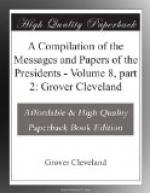to which the President’s proposition directly
applies, and which are designated in the treaty of
peace as the northwest angle of Nova Scotia, formed
by a line drawn due north from the source of the St.
Croix River to the highlands dividing the rivers,
etc.; that the arbiter found it impossible to
decide this point, and therefore recommended a new
line, different from that called for by the treaty
of 1783, and which could only be established by a
conventional arrangement between the two Governments;
that the Government of the United States could not
adopt this recommendation nor agree upon a new and
conventional line without the consent of the State
of Maine; that the present negotiation proposed to
ascertain the boundary according to the treaty of
1783, and for this purpose, however attained, the
authority of the Government of the United States was
complete; that the proposition offered by the Government
of the United States promised, in the opinion of the
President, the means of ascertaining the true line
by discovering the highlands of the treaty, but the
British Government asked the United States as a preliminary
concession to acquiesce in the opinion of the arbiter
upon certain subordinate facts—a concession
which would in effect defeat the sole object, not
only of the proposition, but of the negotiation, viz,
the determination of the boundary according to the
treaty of 1783 by confining the negotiation to a conventional
line, to which this Government had not the authority
to agree. Mr. McLane also said that if by a resort
to the plain rule now recommended it should be found
impracticable to trace the boundary according to the
definitive treaty, it would then be time enough to
enter upon a negotiation for a conventional substitute
for it. He stated in answer to the suggestion
of Sir Charles R. Vaughan that the objection urged
against the line of the arbiter would equally lie
against that suggested by Mr. Livingston; that the
authority of the Government to ascertain the true line
of the treaty was unquestionable, and that the American
proposition, by confining the course to the natural
object, would be a legitimate ascertainment of that
line.
In a note dated 16th March Sir Charles R. Vaughan
offered some observations upon the objections on the
part of the United States to acquiesce in the points
previously submitted to the American Government.
He said that the adoption of the views of the British
Government by the Government of the United States
was meant to be the groundwork of future proceedings,
whether those proceedings were to be directed to another
attempt to trace the boundary as proposed by the latter
or to a division of the territory depending upon the
conventional line. He maintained that the arbiter
had decided, as the British Government asserted, two
out of the three main points submitted for his decision,
viz, what ought to be considered as the northwesternmost
head of the Connecticut (but which the Government




